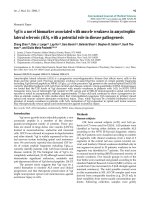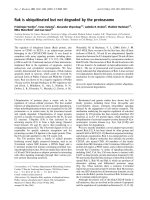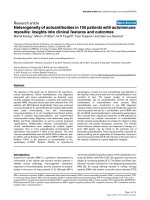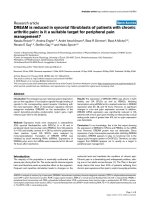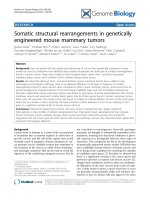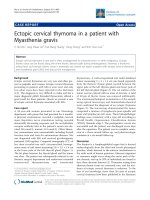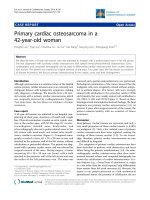Báo cáo y học: "Hepcidin is elevated in mice injected with Mycoplasma arthritidis" ppt
Bạn đang xem bản rút gọn của tài liệu. Xem và tải ngay bản đầy đủ của tài liệu tại đây (679.51 KB, 6 trang )
BioMed Central
Page 1 of 6
(page number not for citation purposes)
Journal of Inflammation
Open Access
Short Report
Hepcidin is elevated in mice injected with Mycoplasma arthritidis
Curry L Koening
1
, Hong-Hua Mu
1
, Adam Van Schelt
1
, Eric Lo
2
,
Diane M Ward
2
, Jerry Kaplan
2
and Ivana De Domenico*
3
Address:
1
Division of Rheumatology, Department of Internal Medicine, University of Utah, School of Medicine, 30 North 1900 East, Salt Lake
City, 84132, Utah, USA,
2
Department of Pathology, University of Utah, School of Medicine, 30 North 1900 East, Salt Lake City, 84132, Utah, USA
and
3
Division of Hematology, Department of Internal Medicine, University of Utah, School of Medicine, 30 North 1900 East, Salt Lake City,
84132, Utah, USA
Email: Curry L Koening - ; Hong-Hua Mu - ; Adam Van
Schelt - ; Eric Lo - ; Diane M Ward - ;
Jerry Kaplan - ; Ivana De Domenico* -
* Corresponding author
Abstract
Mycoplasma arthritidis causes arthritis in specific mouse strains. M. arthritidis mitogen (MAM), a
superantigen produced by M. arthritidis, activates T cells by forming a complex between the major
histocompatability complex II on antigen presenting cells and the T cell receptor on CD4+ T
lymphocytes. The MAM superantigen is also known to interact with Toll-like receptors (TLR) 2 and
4. Hepcidin, an iron regulator protein, is upregulated by TLR4, IL-6, and IL-1. In this study, we
evaluated serum hepcidin, transferrin saturation, ferritin, IL-6, IL-1, and hemoglobin levels in M.
arthritidis injected C3H/HeJ (TLR2
+/+
, TLR4
-/-
) mice and C3H/HeSnJ (TLR2
+/+
, TLR4
+/+
) mice over
a 21 day period. C3H/HeJ mice have a defective TLR4 and an inability to produce IL-6. We also
measured arthritis severity in these mice and the amount of hepcidin transcripts produced by the
liver and spleen. C3H/HeJ mice developed a more severe arthritis than that of C3H/HeSnJ mice.
Both mice had an increase in serum hepcidin within three days after infection. Hepcidin levels were
greater in C3H/HeJ mice despite a nonfunctioning TLR4 and low serum levels of IL-6. Splenic
hepcidin production in C3H/HeJ mice was delayed compared to C3H/HeSnJ mice. Unlike C3H/
HeSnJ mice, C3H/HeJ mice did not develop a significant rise in serum IL-6 levels but did develop a
significant increase in IL-1β during the first ten days after injection. Both mice had an increase in
serum ferritin but a decrease in serum transferrin saturation. In conclusion, serum hepcidin
regulation in C3H/HeJ mice does not appear to be solely dependent upon TLR4 or IL-6.
Background
Mycoplasma arthritidis (M. arthritidis) is a rodent pathogen
that causes arthritis and a toxic shock-like syndrome in
C3H mice. M. arthritidis injected mice have been used as a
mouse model of human inflammatory arthritis for more
than 30 years. Much of the disease phenotype and out-
comes are influenced by the M. arthritidis mitogen (MAM)
superantigen produced by the organism. MAM superanti-
gen activates T cells by forming a complex between the
major histocompatability complex (MHC) II molecule on
antigen presenting cells and the Vβ chain segments of the
T cell receptor (TCR) on CD4+T cells [1]. MAM is a unique
superantigen in that it also interacts with Toll like receptor
(TLR) 4 and 2 found on cells of the innate immune system
Published: 24 November 2009
Journal of Inflammation 2009, 6:33 doi:10.1186/1476-9255-6-33
Received: 3 June 2009
Accepted: 24 November 2009
This article is available from: />© 2009 Koening et al; licensee BioMed Central Ltd.
This is an Open Access article distributed under the terms of the Creative Commons Attribution License ( />),
which permits unrestricted use, distribution, and reproduction in any medium, provided the original work is properly cited.
Journal of Inflammation 2009, 6:33 />Page 2 of 6
(page number not for citation purposes)
[2]. C3H/HeJ mice are particularly susceptible to the
effects of the MAM superantigen. Compared to C3H/
HeSnJ mice, C3H/HeJ mice have a mutant lps
d
gene that
leads to a hypofunctional TLR4 [3]. Macrophages from
C3H/HeJ mice upregulate the number of cell surface TLR2
when exposed to the MAM superantigen [2]. Similarly,
C3H/HeJ injected mice have a type 1 cytokine profile (IL-
2, interferon-γ, and tumor necrosis factor α) compared to
inoculated C3H/HeSnJ mice that have a type 2 cytokine
profile (IL-4, IL-6, and IL-10) [3].
Inflammation also alters iron metabolism. Hepcidin, an
iron regulatory protein, is produced by hepatocytes and
macrophages in response to proinflammatory stimuli.
Hepcidin binds to and down-regulates ferroportin, the
only known cellular iron exporter, found on the plasma
membrane of macrophages, hepatocytes, enterocytes, and
syncytial trophoblasts [4]. Iron accumulates in cells that
lack plasma membrane ferroportin, which leads to lower
amounts of circulating iron available for erythropoiesis.
Anemia caused by the upregulation of hepcidin in sub-
jects with inflammation is known as the anemia of
inflammation (AI). Little is known regarding the regula-
tion of hepcidin in inflammatory states. Investigators
have shown TLR4 activation with lipopolysaccharide
(LPS) leads to the upregulation of hepcidin [5,6]. Mice
injected with Borrelia burgdorferi develop severe arthritis
and increased serum levels of hepcidin. A primary media-
tor of this response is the activation of TLR2 by B. burgdor-
feri on bone marrow macrophages of infected mice [7].
Hepcidin transcription is also upregulated by cytokines
such as IL-1 [8] and IL-6. IL-6 increases hepcidin expres-
sion through activation of the JAK/STAT3 pathway [9-11].
To determine if hepcidin could be expressed independent
of TLR4 activation, we measured serum hepcidin levels in
C3H/HeJ mice (TLR2
+/+
, TLR4
-/-
) and compared the values
to C3H/HeSnJ mice (TLR2
+/+
, TLR4
+/+
) after infection with
M. arthritidis. We found that hepcidin levels were
increased in both mouse strains and hepcidin regulation
was independent of TLR4 and IL-6.
Methods
A total of 36 female mice (10 weeks), 18 C3H/HeJ (TLR2
+/
+
, TLR4
-/-
) and 18 C3H/HeSnJ (TLR2
+/+
, TLR4
+/+
), were
injected with M. arthritidis in accordance with the Univer-
sity of Utah Animal Resource Center as described previ-
ously [12]. Mice were followed for a total of 21 days. Mice
were evaluated for arthritis and toxicity as described previ-
ously immediately after injection and three, seven, ten,
fourteen, and twenty-one days after injection [12]. Three
mice from each group were sacrificed under anesthesia on
the days of arthritis scoring. Blood was collected by car-
diac puncture and serum levels of hepcidin, ferritin, and
transferrin saturation were measured as described previ-
ously [13,14]. Serum IL-6 and IL-1β levels were assayed
using mouse IL-1β and IL-6 ELISA Ready-SET-Go accord-
ing to the manufacture's instructions (eBioscience, San
Diego, CA). Hemoglobin (g/dl) values were measured in
both strains of mice in the University of Utah Division of
Hematology immediately after infection and then three,
10, and 21 days after infection. Livers and spleens were
isolated from each mouse and homogenized. Total RNA
extraction was performed using RNeasy (Qiagen, Valen-
cia, CA) according to the manufacturer's instructions. Fifty
nanograms of mRNA were used for RT-PCR1 Step accord-
ing to the manufacturer's instructions (Invitrogen,
Carlsbad, CA). The primer sequences used for RT-PCR
were HAMP (forward) 5'AGAGCTGCAGCCTTTGCAC3',
HAMP (reverse) 5'GAAGATGCAGATGGGGAAGT3', and
actin (forward) 5'GACGGCCAAGTCATCACTATTG3',
actin (reverse) 5'CCACAGGATTCCATACCCAAGA3'.
Results are reported as mean values ± standard deviation
(SD).
Results
Both C3H/HeJ and C3H/HeSnJ mice developed arthritis
within three days of injection. C3H/HeJ mice developed
more severe arthritis when compared to C3H/HeSnJ mice.
Arthritis severity peaked three days after injection in the
C3H/HeJ mice and 10 days after injection in the C3H/
HeSnJ mice (Figure 1A). Serum hepcidin increased with
arthritis severity in both mouse strains within the first
three days of infection. Hepcidin levels reached their high-
est value 14 days after infection in the C3H/HeJ and 10
days after infection in the C3H/HeSnJ mice. Total serum
hepcidin values were higher in the C3H/HeJ mice. The
mean hepcidin values for the C3H/HeJ and C3H/HeSnJ
mice 21 days after infection were 434.7 ± 54.0 and 311.7
± 9.5 respectively (Figure 1B). Hepcidin transcripts were
detected in the livers of both mouse strains three days
after inoculation. Liver hepcidin peaked by day 14 and
began to decline by day 21 in both strains. Hepcidin tran-
scripts from the spleens of the C3H/HeSnJ mice were
detectable three days after injection but were not detecta-
ble in the spleens of C3H/HeJ mice until seven days after
injection. Levels quickly dropped in both mouse strains
and were undetectable in C3H/HeSnJ mice 10 days after
injection. Hepcidin transcripts in the spleens of C3H/HeJ
mice decreased by day 10 to levels that were four fold
more than C3H/HeSnJ mice (Figure 1C).
Transferrin saturation decreased in both groups of mice.
Values declined more rapidly in the C3H/HeSnJ mice
than in the C3H/HeJ mice but stabilized in both mice
seven days after injection and remained similar through
the end of the study (Figure 2A). Infected mice from both
stains also had lower serum iron levels (data not shown).
Serum ferritin values increased in both groups but were
higher in C3H/HeJ mice compared to C3H/HeSnJ mice
Journal of Inflammation 2009, 6:33 />Page 3 of 6
(page number not for citation purposes)
Serum hepcidin is elevated in mice injected with M. arthritidisFigure 1
Serum hepcidin is elevated in mice injected with M. arthritidis. A. Eighteen female mice (10 weeks) C3H/HeJ and 18
female mice (10 weeks) C3H/HeSnJ mice were injected with M. arthritidis, an organism that causes arthritis and a toxic shock
like syndrome in susceptible mice. Arthritis severity was scored on days 0, 3, 7, 10, 14, and 21 after injection. B. Three mice
were sacrificed on days 0, 3, 7, 10, 14, and 21 after injection and serum hepcidin levels were analyzed. Mean values are
reported as well as standard error bars. Serum hepcidin levels were significantly higher 21 days after infection in the C3H/HeJ
mice than in the C3H/HeSnJ mice. C. Hepcidin transcripts were measured from the livers and spleens of each mouse at each
time point described in B.
Table 1: Mean hemoglobin values ± SD were measured in C3H/HeJ and C3H/HeSnJ mice after injection with M. arthritidis.
Day 0 Day 3 Day 10 Day 21
C3H/HeJ 14.425 ± 0.424 10.825 ± 7.141 13.200 ± 0.353 10.625 ± 0.565
C3H/HeSnJ 10.875 ± 0.919 10.775 ± 2.404 12.275 ± 0.636 10.200 ± 3.670
Journal of Inflammation 2009, 6:33 />Page 4 of 6
(page number not for citation purposes)
Mice injected with M. arthritidis are hypoferremicFigure 2
Mice injected with M. arthritidis are hypoferremic. A. Transferrin saturation was analyzed in C3H/HeJ and C3H/HeSnJ
mice injected with M. arthritidis on days 0, 3, 7, 10, 14, and 21. B. Serum ferritin was analyzed at the same time points in A in
both strains of mice. Mean values are reported as well as standard error bars.
(Figure 2B). Hemoglobin levels in C3H/HeJ mice were
lower at the end of the experiment than at the start (Table
1). In contrast, hemoglobin levels in C3H/HeSnJ did not
change over the course of the experiment.
Serum IL-6 levels were higher in the C3H/HeSnJ mice
compared to C3H/HeJ mice. Serum IL-6 levels did not
greatly increase in the C3H/HeJ mice over the course of
the experiment (Figure 3A). Serum IL-1β levels rapidly
increased in C3H/HeJ mice peaking seven days after M.
arthritidis injection. These levels were much greater than
that seen in the C3H/HeSnJ mice whose levels rose more
slowly and did not peak until 10 days after injection. The
highest serum IL-1β levels observed in C3H/HeSnJ mice
were below the peak levels seen in the C3H/HeJ mice (Fig-
ure 3B).
Discussion
Hepcidin is an important iron regulatory protein that
when overexpressed may lead to hypoferremia and ane-
mia. Systemic inflammation increases the levels of circu-
lating hepcidin that binds to and degrades the cell
membrane receptor ferroportin. By degrading ferroportin,
iron can not be secreted into the plasma and hypofer-
remia develops. Extended periods of low serum iron
decreases erythropoiesis and may lead to anemia. The
Journal of Inflammation 2009, 6:33 />Page 5 of 6
(page number not for citation purposes)
Serum IL-6 and IL-1β are increased in mice injected with M. arthritidisFigure 3
Serum IL-6 and IL-1β are increased in mice injected with M. arthritidis. A. Serum IL-6 levels were measured on days
0, 3, 7, 14, and 21 in C3H/HeJ and C3H/HeSnJ mice after injection with M. arthritidis. B. Serum IL-1β was measured on the
same days as in A. Mean values are reported as well as standard error bars.
mechanisms that lead to increased hepcidin expression
vary among different inflammatory diseases. Hepcidin
transcription may occur secondary to activation of TLR [5-
7] or through increased expression of IL-6 or IL-1 [8-11].
Our results show that hepcidin secretion is affected by the
presence of TLR4 and TLR2. Most notably, the absence of
a functioning TLR4 in C3H/HeJ mice allows for unim-
peded TLR2 activation in response to the MAM superanti-
gen [2]. Unimpeded TLR2 activation may lead to the
overexpression of hepcidin in the infected C3H/HeJ mice.
Previous studies indicate that IL-6, a proinflammatory
cytokine, is a major inducer of hepcidin transcription.
Our studies show that C3H/HeJ mice express low serum
levels of IL-6 but have high levels of IL-1β, a cytokine also
known to induce hepcidin transcription. Splenic macro-
phages activated by TLR appear to be important sources of
hepcidin. Our results show that mice livers and spleens
have different expression patterns of hepcidin mRNA.
Hepcidin secretion from the spleens of C3H/HeSnJ mice
and from the livers of both C3H/HeSnJ and C3H/HeJ
mice occurs shortly after injection of M. arthritidis. How-
ever, splenic expression of hepcidin transcripts in C3H/
Journal of Inflammation 2009, 6:33 />Page 6 of 6
(page number not for citation purposes)
HeJ mice is not detectable until several days after injec-
tion. The amount of serum hepcidin contributed by the
spleen versus the liver is not known but we speculate
splenic hepcidin production contributes a great deal to
the serum levels of hepcidin seen in our experiments. Fur-
thermore, both the presence and absence of TLR4 affects
hepcidin secretion in response to inflammatory agents.
Our results show that C3H/HeJ mice have higher levels of
serum hepcidin and ferritin than C3H/HeSnJ mice and
that both strains have low transferrin saturation values 21
days after infection. Hemoglobin values were lower
through out the experiment in the C3H/HeSnJ mice com-
pared to the C3H/HeJ mice. We speculate the lower
hemoglobin values may be specific for this strain but can
not rule out that they may be due to an immediate reac-
tion to the infection. The hemoglobin values for the C3H/
HeJ mice were lower at the end of the experiment than at
the beginning, but this was not seen in the C3H/HeSnJ
mice. We suspect 21 days is not enough time to see a sig-
nificant decline in hemoglobin values and if these mice
were followed for a longer period of time, the serum
hemoglobin values would decline further. We also specu-
late that the variation of hemoglobin values in both
strains of mice at each time point represents the diverse
systemic responses that can be seen in these mice after
infection with M. arthritidis.
Limitations to our study include its small sample size and
short period of followup. Furthermore, the sickest mice
were sacrificed at each time point. Selecting the sickest
mice for sacrifice gives a false impression that arthritis
improves with time and makes it difficult to calculate sta-
tistical differences at each time point. It also allows for
healthier mice to be analyzed later in the study and may
be another reason why hemoglobin values had not
declined further in both strains of mice by the end of the
study.
Conclusion
In conclusion, serum hepcidin regulation in states of
inflammation appears more complex than originally
thought. Serum hepcidin may be upregulated independ-
ently of IL-6 and TLR4 activation. Splenic and liver hepci-
din regulation is controlled by different mechanisms.
TLR2 appears important in the regulation of hepcidin in
M. arthritidis infected mice, but further work is needed to
determine the exact mechanism of hepcidin expression in
these mice.
Competing interests
The authors declare that they have no competing interests.
Authors' contributions
CLK, IDD, and JK conceived the study; CLK, IDD, and EL
performed the experiments; CLK and IDD authored the
manuscript; HHM and AVS performed the M. arthritis
infection; DMW and JK analyzed the data and approved
the manuscript. All authors read and approved the final
manuscript.
Acknowledgements
This work was supported by the NIH Center of Excellence in Molecular
Hematology grant SP30 DK072437 and an NIH grant DK070947 to JK. Dr.
Koening is supported by the Public Health Services research grant numbers
UL1-RR025764 and C06-RR11234 from the National Center for Research
Resources and Dr. Mu is supported by a grant from the Nora Eccles Tread-
well Foundation. The authors would like to thank Dr. Gerald Spangrude for
measuring hemoglobin values.
References
1. Cole BC, Mu HH: From Mycoplasma arthritidis-derived super-
antigen (MAM), a unique class of superantigen that bridges
innate and adaptive immunity. In Superantigens: Molecular Basis
for their Role in Human Diseases Edited by: Kotb M, Fraser JD. Wash-
ington, D.C.: ASM Press; 2007:37-57.
2. Mu HH, Pennock ND, Humphreys J, Kirschning CJ, Cole BC:
Engagement of Toll-like receptors by mycoplasmal superan-
tigen: downregulation of TLR2 by MAM/TLR4 interaction.
Cell Microbiol 2005, 7:789-797.
3. Mu HH, Sawitzke AD, Cole BC: Presence of Lps(d) mutation
influences cytokine regulation in vivo by the Mycoplasma
arthritidis mitogen superantigen and lethal toxicity in mice
infected with M. arthritidis. Infect Immun 2001, 69:3837-3844.
4. De Domenico I, McVey Ward D, Kaplan J: Regulation of iron
acquisition and storage: consequences for iron-linked disor-
ders. Nat Rev Mol Cell Biol 2008, 9:72-81.
5. Peyssonnaux C, Zinkernagel AS, Datta V, Lauth X, Johnson RS, Nizet
V: TLR4-dependent hepcidin expression by myeloid cells in
response to bacterial pathogens. Blood 2006, 107:3727-3732.
6. Theurl I, Theurl M, Seifert M, Mair S, Nairz M, Rumpold H, Zoller H,
Bellmann-Weiler R, Niederegger H, Talasz H, Weiss G: Autocrine
formation of hepcidin induces iron retention in human
monocytes. Blood 2008, 111:2392-2399.
7. Koening CL, Miller JC, Nelson JM, Ward DM, Kushner JP, Bockenst-
edt LK, Weis JJ, Kaplan J, De Domenico I: Toll-like receptors
mediate induction of hepcidin in mice infected with Borrelia
burgdorferi. Blood 2009, 114:1913-1918.
8. Lee P, Peng H, Gelbart T, Wang L, Beutler E: Regulation of hepci-
din transcription by interleukin-1 and interleukin-6. Proc Natl
Acad Sci USA 2005, 102:1906-1910.
9. Nemeth E, Rivera S, Gabayan V, Keller C, Taudorf S, Pedersen BK,
Ganz T: IL-6 mediates hypoferremia of inflammation by
inducing the synthesis of the iron regulatory hormone hepci-
din. J Clin Invest 2004, 113:1271-1276.
10. Pietrangelo A, Dierssen U, Valli L, Garuti C, Rump A, Corradini E,
Ernst M, Klein C, Trautwein C: STAT3 is required for IL-6-
gp130-dependent activation of hepcidin in vivo. Gastroenterol-
ogy 2007, 132:294-300.
11. Wrighting DM, Andrews NC: Interleukin-6 induces hepcidin
expression through STAT3. Blood 2006, 108:3204-3209.
12. Mu HH, Sawitzke AD, Cole BC: Modulation of cytokine profiles
by the Mycoplasma superantigen Mycoplasma arthritidis
mitogen parallels susceptibility to arthritis induced by M.
arthritidis. Infect Immun 2000, 68:1142-1149.
13. De Domenico I, Nemeth E, Nelson JM, Phillips JD, Ajioka RS, Kay MS,
Kushner JP, Ganz T, Ward DM, Kaplan J: The hepcidin-binding
site on ferroportin is evolutionarily conserved. Cell Metab
2008, 8:146-156.
14. De Domenico I, Vaughn MB, Li L, Bagley D, Musci G, Ward DM, Kap-
lan J: Ferroportin-mediated mobilization of ferritin iron pre-
cedes ferritin degradation by the proteasome. EMBO J 2006,
25:5396-5404.
